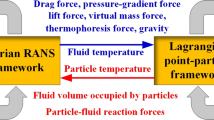Abstract
A model of the motion of an admixture of polydisperse solid particles in a horizontal plane channel with account for particle deposition on the bottom wall is presented. The dispersed phase, consisting of six particle fractions characterized by the particle size and the mass concentration, is modeled in Eulerian form. Interparticle collisions occur due to the difference in the velocities of average motion of the fractions and to particle velocity fluctuations. It is important to take interparticle collisions into account for flows with a high particle mass loading (in the model, up to 50 kg per kg of gas) and because of the gravity-induced particle accumulation on the bottom wall. To ensure a correct description of the particle-wall collisions, impinging and rebounding particle streams with the corresponding restitution coefficients for the normal and tangential particle velocities and friction are introduced. The calculations are compared with experiments [1].
Similar content being viewed by others
References
Y. Tsuji and Y. Morikawa, “LDV measurements of an air-solid two-phase flow in a horizontal pipe,” J. Fluid Mech., 120, 385–409 (1982).
J. T. Davies, “Calculation of critical velocities to maintain solids in suspension in horizontal pipes,” Chem. Engn. Sci., 42, No. 7, 1667–1670 (1987).
F. J. Cabrejos and G. E. Klinzing, “Pickup and saltation mechanisms of solid particles in horizontal pneumatic transport,” Powder Technology, 79, No. 2, 173–186 (1994).
M. Sommerfeld, “Analysis of collision effects for turbulent gas-particle flow in a horizontal channel: Pt 1. Particle transport”, Int. J. Multiphase Flow, 29, No. 4, 675–699 (2003).
M. Sommerfeld, “Validation of a stochastic Lagrangian modelling approach for interparticle collisions in homogeneous isotropic turbulence”, Int. J. Multiphase Flow, 27, No. 10, 1829–1858 (2001).
B. Oesterle and A. Petitjean, “Simulation of particle to particle interactions in gas-solid flows,” Int. J. Multiphase Flow, 19, No. 1, 199–211 (1993).
T. Tanaka and Y. Tsuji, “Numerical simulation of gas-solid two-phase flow in vertical pipe: On the effect of interparticle collision”, in: Proc. 4th Int. Symp. Gas-Solid Flows, Portland, ASME, 1991, FED-V, 121, (1991), pp. 123–128.
M. Y. Louge, E. Mastorakos, and J. T. Jenkins, “The role of particle collisions in pneumatic transport,” J. Fluid Mech., 231, 345–359 (1991).
J. Cao and G. Ahmadi, “Gas-particle two-phase turbulent flow in vertical duct,” Int. J.Multiphase Flow, 21, No. 6, 1203–1228 (1995).
D. Gidaspov, Multiphase Flow and Fluidization, Acad. Press, Boston etc. CA (1994).
A. Kartishinsky and E. E. Michaelides, “An analytical approach for the closure equations of gas-solid flows with interparticle collisions,” Int. J. Multiphase Flow, 30, No. 2, 159–180 (2004).
C. T. Crowe and I. Gillandt, “Turbulence modulation of fluid-particle flows — a basic approach,” in: Proc. 3d Int. Conf. Multiphase Flow, Lyons, 1998 (1998).
H. Danon, M. Wolfshtein, and G. Hetstroni, “Numerical calculations of two-phase turbulent round jet,” Int. J. Multiphase Flow, 3, No. 3, 223–234 (1997).
S. Elghobashi and T. W. Abou-Arab, “A two-equation turbulence model for two-phase flows,” Phys. Fluids, 26, No. 4, 931–938 (1983).
C. P. Chen and P. E. Wood, “Turbulence closure modeling of two-phase flows,” Chem. Engng. Communs., 29, 291–310 (1984).
F. Pourahmadi and J.A.C. Humphrey, “Modeling solid-fluid turbulent flows with application to predicting erosive wear,” Phys. Chem. Hydrodyn., 4, No. 3, 191–219 (1983).
A. A. Shraiber, L. B. Gavin, V. A. Naumov, and V. P. Yatsenko, Turbulent Gas-Solid Flows [in Russian], Naukova Dumka, Kiev (1987).
A. I. Kartushinskii, E. E. Michaelides, and Yu. A. Rudi, “Numerical modeling of gas-particle flows in vertical pipes and the particle collision effect,” Fluid Dynamics, 39, No. 5, 748–755 (2004).
M. Hussainov, A. Kartushinsky, A. Mulgi, Ü. Rudi, and S. Tisler, “Gas-solid flow with the slip velocity of particles in a horizontal channel,” J. Aerosol Sci., 27, No. 1, 41–59 (1996).
G. N. Abramovich, T. A. Girshovich, S. Yu. Krasheninnikov, et al., Turbulent Jet Theory [in Russian], Nauka, Moscow (1984).
L. Schiller and A. Naumann, “Über die grundlegenden Berechnungen bei der Schwerkraftaufbereitung,” Z. Ver. Deut. Ing., 77, 318–320 (1933).
S. Matsumoto and S. J. Saito, “Monte carlo simulation of horizontal pneumatic conveying based on the rough-wall model,” Chem. Engng. Japan, 3, No. 2, 223–230 (1970).
S. I. Rubinow and J. B. Keller, “The transverse force on a spinning sphere moving in a viscous fluid,” J. Fluid Mech., 11, Pt 3, 447–459 (1961).
R. Mei, “An approximate expression for the shear lift force on a spherical particle at finite Reynolds number,” Int. J. Multiphase Flow, 18, No. 1, 145–147 (1992).
Y. Yamomoto, M. Potthoff, T. Tanaka, T. Kajishima, and Y. Tsiji, “Large-eddy simulation of turbulent gas-particle flow in a vertical channel: effect of considering interparticle collisions,” J. Fluid Mech., 442, 303–334 (2001).
J. Ding, R.W. Lyczkowski, W.T. Sha, S.A. Altobelli, and E. Fukushima, “Numerical analysis of liquid-solids suspension velocities and concentrations obtained by NMR imaging,” Powder Technology, 77, 301–312 (1993).
S. Chapman and T.G. Cowling, The Mathematical Theory of Nonuniform Gases, Cambridge Univ. Press, Cambridge (1952).
C. Crowe, M. Sommerfeld, and Y. Tsuji, Multiphase Flows with Droplets and Particles, CRC Press, Boca Raton, Florida (1998).
F. Frishman, M. Hussainov, A. Kartushinsky, and A. Mulgi, “Numerical simulation of a two-phase turbulent pipe-jet flow loaded with polyfractional solid admixture,” Int. J. Multiphase Flow, 23, No. 4, 765–796 (1997).
F. E. Marble, “Mechanism of particle collision in one-dimensional dynamics of gas-particle admixture,” 7, No. 8, 1270–1282 (1964).
Additional information
__________
Translated from Izvestiya Rossiiskoi Academii Nauk, Mekhanika Zhidkosti i Gaza, No. 2, 2006, pp. 76–87.
Original Russian Text Copyright © 2006 by Kartushinskii, Michaelides, and Rudi.
Rights and permissions
About this article
Cite this article
Kartushinskii, A.I., Michaelides, E.E. & Rudi, Y.A. Modeling of high-concentration gas-particle flow in a horizontal channel. Fluid Dyn 41, 237–248 (2006). https://doi.org/10.1007/s10697-006-0037-8
Received:
Issue Date:
DOI: https://doi.org/10.1007/s10697-006-0037-8




